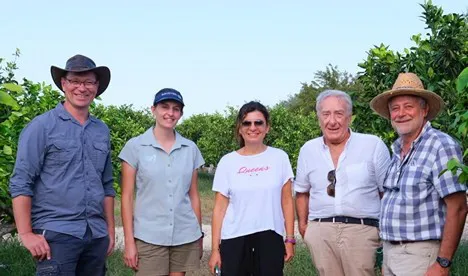The NovArancia project, a project funded by the RDP Rural Development Programme Sicily 2014-2022 of 08/10/2018, which aims to introduce 'Technological innovations for the valorization and traceability of the Blood Orange,' is proceeding at a rapid pace. These include High Throughput Sequencing (HTS) of the plant genome and any viruses and viroids that could possibly be found, and bioinformatic analysis of the respective genomes.
This is a technology used for a variety of purposes and which the NovArancia project intends to finalize for genetic and health certification of progenitor mother plants of different red-fleshed orange clones.
 Hans J. Maree, Rachelle Bester, Grazia Licciardello, Antonino Catara, Salvatore Leocata
Hans J. Maree, Rachelle Bester, Grazia Licciardello, Antonino Catara, Salvatore Leocata
"In the phytosanitary field," explained Antonino Catara, Innovation broker of the project, "the most advanced results on the use of HTS have been obtained by Professor Hans J Maree and Dr. Rachelle Bester, who work at the Citrus Research International (CRI) and the University of Stellenbosch in South Africa. Both have developed successful methods."
The two experts presented the strategy to obtain propagation materials that are clear of any pathogen to researchers, representatives of the Regional Plant Health Service and students the experience of South Africa regarding the management of Tristeza and Huanglongbing, at the Di3A Department of the University of Catania.
Rachelle Bester recalled that HTS has been a major contributor to the discovery of numerous viruses and viroids in many crops, and that many countries are investigating how to apply it in routine phytosanitary programs. In the case of citrus, several protocols were examined in South Africa for comparison with the RT-PCR molecular assay and found to be reliable and comparable. In both cases, the concentration of the pathogen and the method of extraction from the sample can influence the result; these obstacles can be surmounted more easily with HTS by increasing the depth of sequencing. Through Illumina methodology, they have achieved accurate virome profiling and process validation."
Grazia Licciardello, a researcher at CREA in Acireale, who has already developed an HTS analysis procedure applied to citrus, functional for phytosanitary surveillance activities and control of products at risk, for her part, explains how "in the NovArancia project, Agrobiotech and CREA are pursuing the validation of the method also for application to the certification of basic category propagation material, whose phytosanitary ascertainment process requires long analysis times (6-12 months)."
"In NovArancia, in addition to the HTS/RT-PCR comparison, great attention is paid to the comparison with biological testing on indicator plants, as they are officially recognized at an international scale. The final goal is to define the possible areas of adoption in the Italian and EU regulatory system," continued Liccardello.
The seminar was followed by visits to citrus groves, coordinated by Salvatore Leocata (ASA), and meetings with Agrobiotech and CREA-Acireale researchers participating in the NovArancia project, at the end of which collaboration approaches were examined with regard to validation and simplification of the procedure.
For more information:
www.novarancia.it
